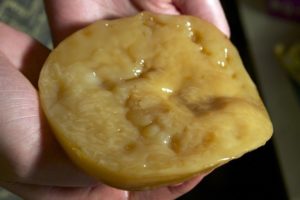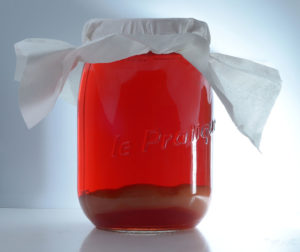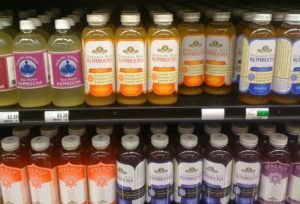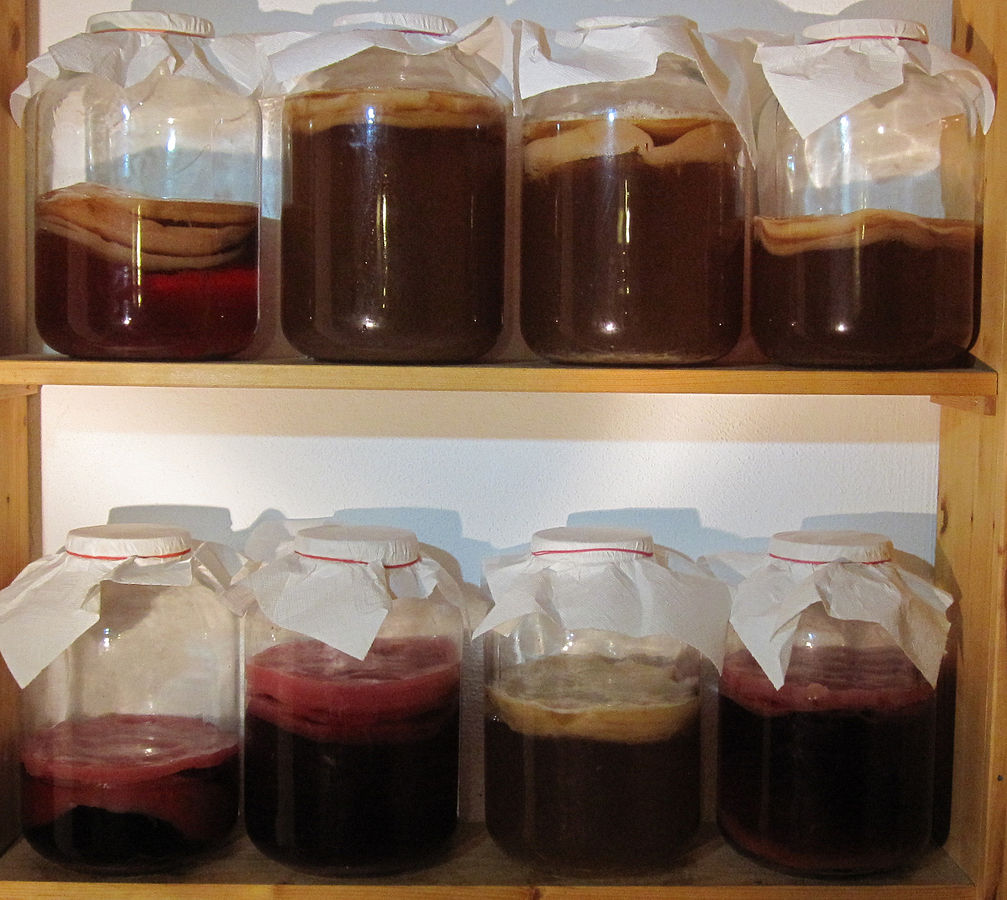

I was first introduced to Kombucha in 1980. Members who belonged to my Natural Food Co-op shared the “mother culture” of Kombucha.
Kombucha has a long history of use in cultures around the world. Some historical documents trace the drink back to Manchuria around 220 BCE. The name Kombucha is thought to be linked to the Japanese physician, Kombu, who is credited with importing it into Japan in 414 CE. The drink was traditionally used primarily in Asia, Russia, and eastern Europe. In China it claimed the name “Immortal Health Elixir”, while in Russia it was called “tea kvass”. Traditional beliefs include health benefits from Kombucha that range from immune support and anti-inflammatory effects to enhanced energy and sexual prowess.
 Many people choose to make their own homemade Kombucha. To do so, you have to track down a small piece of the ‘mother culture’ which is placed into a jar of tea (black or green, its all made from the same plant, Camellia sinensis) , and quite a bit of sugar is added. The mother culture is called SCOBY (Symbiotic Culture of Bacteria and Yeast), and is actually a combination of bacterial and yeast cultures, usually including Saccharomyces cerevisiae, Brettanomyces bruxellensis, Candida stellata and Gluconacetobacter xylinus– a bacteria that helps to oxidize yeast-produced alcohols into acetic acid, which gives Kombucha its signature slight vinegar-like taste. After leaving the solution to ferment, a large mushroom-like organism grows in the liquid, called a zoogeleal mat. Then, the liquid is strained into a glass to consume.
Many people choose to make their own homemade Kombucha. To do so, you have to track down a small piece of the ‘mother culture’ which is placed into a jar of tea (black or green, its all made from the same plant, Camellia sinensis) , and quite a bit of sugar is added. The mother culture is called SCOBY (Symbiotic Culture of Bacteria and Yeast), and is actually a combination of bacterial and yeast cultures, usually including Saccharomyces cerevisiae, Brettanomyces bruxellensis, Candida stellata and Gluconacetobacter xylinus– a bacteria that helps to oxidize yeast-produced alcohols into acetic acid, which gives Kombucha its signature slight vinegar-like taste. After leaving the solution to ferment, a large mushroom-like organism grows in the liquid, called a zoogeleal mat. Then, the liquid is strained into a glass to consume.
WARNING: Do not dispose of any part of the organism by pouring it down the drain, since it can grow in the pipes or the sewer to enormous proportions and ‘clog the works.’
CAUTIONS: Although negative reactions are rare, there have been reports of sickness due to contamination, especially in ‘home-made’ kombucha.
 Science has validated many healthy components that Kombucha contains, such as glucaric acid B-vitamins and antioxidants. Current research on the healing effects of Kombucha is exploding, as Kombucha rapidly rises as a formidable force in popularity in the commercial market. Research includes investigations into Kombucha’s role for cardiovascular health (Protective effect of kombucha on rats fed a hypercholesterolemic diet is mediated by its antioxidant activity. Pharm Biol. 2015;53(11):1699-709) and support for the liver in its important role in detoxification. (Hepatoprotective effects of kombucha tea: identification of functional strains and quantification of functional components. J Sci Food Agric. 2014 Jan 30;94(2):265-72)
Science has validated many healthy components that Kombucha contains, such as glucaric acid B-vitamins and antioxidants. Current research on the healing effects of Kombucha is exploding, as Kombucha rapidly rises as a formidable force in popularity in the commercial market. Research includes investigations into Kombucha’s role for cardiovascular health (Protective effect of kombucha on rats fed a hypercholesterolemic diet is mediated by its antioxidant activity. Pharm Biol. 2015;53(11):1699-709) and support for the liver in its important role in detoxification. (Hepatoprotective effects of kombucha tea: identification of functional strains and quantification of functional components. J Sci Food Agric. 2014 Jan 30;94(2):265-72)
With all the new excitement about Kombucha as a rising star in the drink category, the FDA has decided to investigate the safety of Kombucha, since the fermentation process used to make it includes the natural production of a small amount of alcohol- usually less than .05%.( Don’t expect a buzz!) Professional organizations, such as the AHPA (American Herbal Products Association) are offering courses to manufacturers to learn how to comply with new FDA regulations. If you would like to try Kombucha, visit your local health food store. They will carry brands that are made in GMP( Good Manufacturing Practice) regulated facilities. Or, if you find someone who has a mother culture, you can experiment with making your own!
Image credits:
SCOBY – By Lukas Chin – Own work, CC BY-SA 4.0, https://commons.wikimedia.org/w/index.php?curid=39194866
Kombucha in Black Fruit Tea – By Simon A. Eugster (Own work) [GFDL (http://www.gnu.org/copyleft/fdl.html) or CC BY-SA 3.0 (http://creativecommons.org/licenses/by-sa/3.0)], via Wikimedia Commons
Commercial Kombucha – http://kombuchahome.com/
Kombucha brewing – By Original-kombucha – Own work, CC BY-SA 3.0, https://commons.wikimedia.org/w/index.php?curid=21415717
Mgarten at the English language Wikipedia [GFDL (http://www.gnu.org/copyleft/fdl.html) or CC-BY-SA-3.0 (http://creativecommons.org/licenses/by-sa/3.0/)], via Wikimedia Commons

